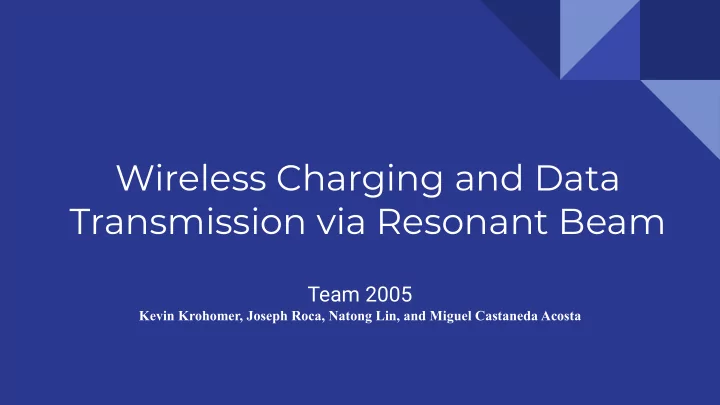

Wireless Charging and Data Transmission via Resonant Beam Team 2005 Kevin Krohomer, Joseph Roca, Natong Lin, and Miguel Castaneda Acosta
Outline ● Background ● Constraints ● Problem ● RACI Chart ● Solution ● Budget ● Final Design ● Project Timeline for Fall ● Transmitting Circuit 2019 ● Receiving Circuit ● Project Timeline for Spring 2020
Background Wi-Charge is exploring wireless power transmission. ● EE Department is looking to expand this technology. ● Wireless power and high-rate data transfer. ● We are looking to explore if this can be done efficiently. ● https://pbs.twimg.com/profile_images/1152296500921286658/HOsbcNYg.jpg https://icdn1.digitaltrends.com/image/digitaltrends/cafe-iamge-wide-with-beams-416x416.jpg
Problem ● Develop a system that can wirelessly charge a device Relatively new technology ● Based off technology introduced by the company Wi-Charge ● ● Potentially will eliminate or reduce the use of wired charging
Solution ● Use a wireless transmitter and receiver system Transmitter ● ○ Laser transmitting system ○ Generates and sends a laser containing certain wattage to the receiver Receiver ● ○ Receives laser signal and turns it into voltage Feedback laser to transmitter ○
Transmitting Circuit ● Power Supply ● 10 W Laser Second Power Supply ● ● 1.6 W IR Laser ● Photodetector ● Microcontroller Beam Expander ●
10 W 520 nm Laser ● The main transmitting signal Sends 10 W of power to the PV cell ● Laser produces photons at 520 nm ● ● Size: 23 mm X 207 mm ● Beam Diameter: 2 mm
20X Achromatic Beam Expander Expands the beam diameter ● ○ 2.0 mm → 40.0 mm ● Galilean expander design Suitable for high power lasers ○
Power Supply Used to power the 10 W laser ● ● Uses a transformer, voltage regulator, full bridge rectifier, and an RC filter All circuit components calculated to get the right output voltage ○ ● Converts AC input out of the power socket to DC input to power the laser
1.6 W IR Laser ● Laser used as a switch for the entire system 10 W laser is powerful so we need a mechanism to ensure safety ○ ● Trip wire used to shut off the entire system if touched
Photodetector ● Data ○ Spectral Range: 400 - 1100 nm ○ Sensor Size: 11.3 mm ○ Maximum Measurable Power: 2.0 W To detect the optical feedback from the ● corner reflector located in the receiver end Detects when the laser is not feeding a ● signal into it
Microcontroller ● Microcontroller is an integrated circuit that can be programmed for a specific purpose Receives signal from photodetector and ● turns the power supply off or keeps the power supply on based on that input
Receiving Circuit PV Cells ● ● Qi Receiver ● Corner Reflector Device ●
Corner Reflector ● Used to reflect the 1.6 W laser beam back from where it came Retroreflector ● ○ Protective silver coating to reflect wavelengths between 400 nm - 1000 nm ○ Perfect reflector in our situation
PV Cells ● Takes in laser beam as input and converts it into voltage ● Used to power the Qi receiver so the device can charge ● Efficiency: 47.1% Efficiency = 1.12 eV/ 2.38 eV = 47.1% ○ ○ PV Cell can take in 47.1% of power and turn that into voltage
Qi Receiver ● Takes the voltage from the PV cells and uses it as a power source ● Uses inductance to charge the device ○ Consists of a coil of wires around a bar magnet ○ Induces a magnetic field that creates enough of a current to charge the device ○ Needs a 5 V power supply to work
Qi Receiving Circuit
Final Design for Power Transmission
Final System Design
Constraints Technical ● - Efficiency - Amplification - Alignment of components Societal ● - Safety ● Budget - Resonant cavity - Optical components
Budget Final Design Component Cost 10 W Laser pointer (520 nm) $129.99 1.6 W IR Laser Module (980 nm) $315.00 20X Achromatic Beam Expander $712.03 Photovoltaic Cell $7.15 Qi Receiver $14.95 Corner Reflector $375.00 Photodetector $645.00 Photodiode $55.72 Electrical components $18.97 Planar Reflector $0.93 DC-DC Converter $0.75 Beam splitters $193.00 Total $2,468.49
RACI Chart Team Members Advisors/Sponsors Activity Joseph Roca Kevin Krohomer Natong Lin Miguel Castaneda Acosta Eric Donkor Shengli Zhou Communications Module R C R C A A Meet with Faculty Advisor R R R R A A Maintain Schedule C C C R I I Update the website C C C R I I Budget and Supplies Table C R C C A A Laser Theory & Laser Testbed Setup C C R R A A Microcontroller Software & Receiver Circuit R R C C A A Power Supply & Photovoltaic cell R C R C A A Switching circuit & Photodetector C R C R A A Written Proposal R C R C A A Design Review PowerPoint C R C R A A Final Presentation PowerPoint R C R C A A Final Written Report C R C R A A R Responsible The person responsible for getting the work done A Approvers The person who must approve the completed work C Consulted Anyone who will participate in the work I Informed Anyone who needs to know about work status or completion
Project Timeline for Fall 2019
Project Timeline for Spring 2020
Thank you
Recommend
More recommend